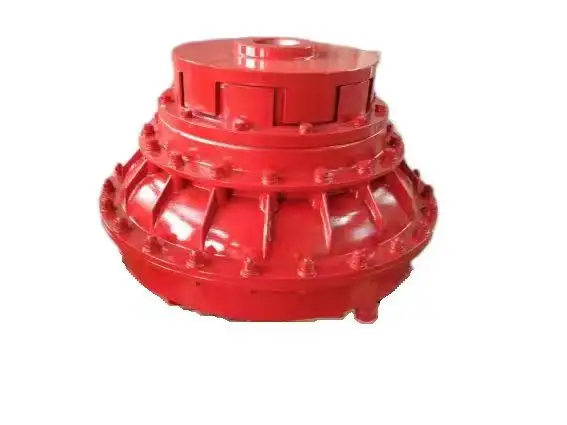Product Description
Hot Sale Spider Coupling Rubber For Flexible Pump Shaft Coupling
HangZhou CHINAMFG Industry Co., Ltd. introduces a new standard polyurethane material for its spiders, offering enhanced performance and durability. The improved material is designed to withstand higher temperatures, ensuring a longer service life compared to the previous polyurethane material.
Our spider couplings are highly customizable, allowing users to tailor the performance to their specific application needs. The spiders are available in 3 durometers, providing options for different levels of dampening and torsional stiffness. Choose from 85 Shore A for maximum dampening, 92 Shore A for a balance of dampening and torsional stiffness, or 98 Shore A for a small amount of dampening and the highest torsional stiffness.
With stand offs on the spider limbs, our couplings make installation easier by maintaining proper spacing between the 2 hubs. This ensures electrical isolation and enables full angular misalignment capabilities.
Designed as the wear element of the coupling, the spiders can be easily replaced, making it a cost-effective solution while restoring the full performance abilities of the coupling.
| Size | GE19 GE24 GE28 GE38 GE42 GE48 GE55 GE65 GE75 GE90 GE100 GE110 GE125 GE140 GE160 GE180 |
| Material | Rubber/PU |
| Colour | Yellow, Red |
| Spider Hardness | Yel1ow: 92SHA; Blue: 95SHA; Red: 98SHA |
| Packing | Plastic film, plastic bag, Bubble bag, Color Box, Blister card…etc |
/* January 22, 2571 19:08:37 */!function(){function s(e,r){var a,o={};try{e&&e.split(“,”).forEach(function(e,t){e&&(a=e.match(/(.*?):(.*)$/))&&1

Protection Against Leaks and Contamination in Oil Couplings
Oil couplings are designed with various features and practices to prevent leaks and contamination, ensuring their reliable operation:
- Sealing Mechanisms: High-quality seals and gaskets are used at critical points to prevent oil leakage and entry of contaminants.
- Seal Maintenance: Regular inspection and replacement of seals and gaskets help maintain their integrity and prevent leaks.
- Enclosures: Some oil couplings are housed within protective enclosures that shield them from external debris, dust, and moisture.
- Oil Filtration: Some systems incorporate oil filtration units to remove contaminants and particles from the oil before it enters the coupling.
- Oil Analysis: Regular oil analysis helps monitor the condition of the lubricant and detect contaminants or degradation early.
- Proper Installation: Precise installation and alignment reduce the risk of seal damage and misalignment-related leaks.
- Clean Environment: Maintaining a clean operating environment minimizes the likelihood of contaminants entering the coupling.
- Oil Reservoir Design: Well-designed reservoirs and chambers within the coupling can prevent oil from escaping and contaminants from entering.
- Seal Design: Advanced seal designs with protective features can provide enhanced resistance to leaks and contamination.
Through these protective measures, oil couplings can effectively safeguard against leaks and contamination, ensuring their continued performance and reliability.

Handling High Torque and Variable Speeds with Oil Couplings
Oil couplings are well-suited for applications that involve high torque and variable speeds due to their unique design and operating principle. Here’s how they handle these challenges:
- High Torque: Oil couplings can effectively handle high torque levels by using the fluid’s viscosity and shear properties to transmit torque. As torque increases, the viscosity of the oil also increases, enhancing its ability to transmit power. This characteristic allows oil couplings to withstand sudden spikes in torque without causing damage.
- Variable Speeds: Oil couplings are inherently capable of accommodating variable speeds. The viscosity of the oil can adjust to changing speeds, ensuring smooth power transmission even when the rotational speed varies. This flexibility is particularly beneficial in applications where the load or operating conditions may change frequently.
By relying on the fluid properties of the oil, oil couplings can maintain stable and efficient power transmission across a range of torque levels and speeds. This makes them suitable for applications that require high torque, variable speeds, and adaptability to changing operating conditions.

Oil Couplings: Definition and Applications
An oil coupling, also known as a hydrodynamic coupling or fluid coupling, is a mechanical device used to transmit power between two rotating shafts while allowing for controlled slip and torque multiplication. It operates based on the principle of fluid dynamics and is commonly used in various applications:
1. Automotive Industry: Oil couplings are used in automatic transmissions to connect the engine’s torque output to the transmission, enabling smooth shifting and gradual power delivery.
2. Industrial Machinery: They are employed in industrial equipment like conveyors, crushers, and mixers, where gradual startup and overload protection are necessary.
3. Mining and Material Handling: Oil couplings facilitate soft start and controlled acceleration in heavy-duty applications, reducing stress on machinery and improving efficiency.
4. Power Generation: They are used in power plants to connect turbines and generators, providing a cushioned startup and load adjustment.
5. Marine Applications: Oil couplings are used in ship propulsion systems to smoothly transmit power from engines to propellers, ensuring gradual acceleration.
6. Pumps and Compressors: They are utilized in pumps and compressors to ensure smooth operation during startup and to protect the equipment from sudden load changes.
7. Construction Equipment: Oil couplings are found in equipment like cranes, excavators, and loaders, providing controlled power transmission and preventing shock loads.
8. Wind Turbines: In wind turbines, oil couplings connect the blades and the generator, allowing the turbine to start up gradually and adjust to wind conditions.
9. Agricultural Machinery: They are used in tractors and other agricultural equipment to provide smooth engagement of power between the engine and the transmission.
Oil couplings work by using a fluid-filled chamber to transfer torque. The fluid’s viscosity creates resistance, allowing controlled slippage and torque multiplication as needed. This makes them useful in applications where shock loads and abrupt changes in torque can cause damage. Their ability to provide gradual startup and controlled power transmission makes them valuable in various industries.


editor by CX 2024-04-12
by
Leave a Reply